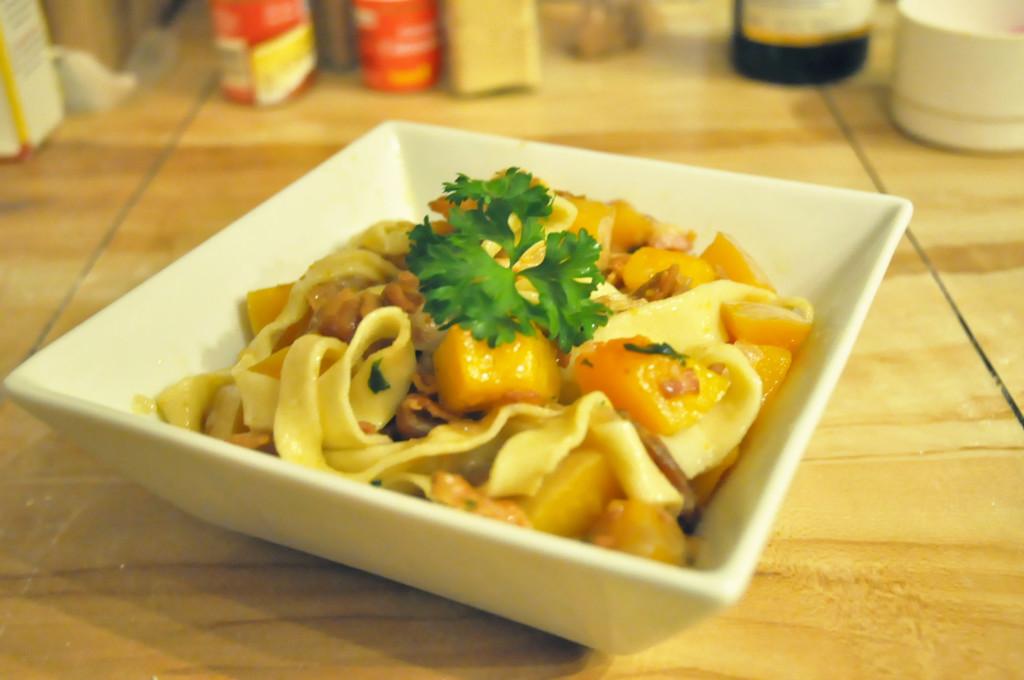In a Nut Shell: Fresh Pasta with Butternut Squash and Smoked Bacon
It’s our first savory recipe. Ready? Butternut squash has a very fall-reminiscent feel. Its subdued warm orange color will look amazing mixed with smoked bacon. And of course, fresh pasta.
We’ll start with the homemade pasta.
Recipe (inspired by the Cooking Channel): Pasta Dough
Notes
-
Difficulty: Medium, but fairly easy if you have a standing mixer.
-
Length: Depending on your kneading stamina, 15-30 minutes.
-
Keep in mind: the dough cannot be sticky in any way. You need to knead a lot. A lot. Also, the dough needs to be rolled out evenly and thinly.
-
Why we made it: it’s fresh pasta.
-
Why you should make it: boasting rights. Have you tasted fresh pasta? Actual bliss.
Ingredients (for one serving):
-
3/4 cups flour
-
1 egg
-
1/4 teaspoon extra-virgin olive oil
You will also need:
-
Clean work surface
-
Fork
-
Either serious kneading stamina or a standing mixer with a dough hook attachment
-
Rolling pin or pasta sheet roller attachment
- Knife or noodle-making roller attachment
Dump the measured flour onto a clean work surface and make a well in the center.
Crack the eggs into the well. We tripled the recipe because we were feeding others, so don’t be intimidated by the three eggs.
Add the salt and drizzle in the olive oil. Then, starting from the center, whisk away with a fork.
As you whisk, pull flour into the eggs slowly from the walls of the well, making sure to incorporate each addition before adding more. We promise you it will look disgusting at first.
Now here comes your mini workout. Knead, knead, knead! (Turn, push, fold, and repeat. Or just use a standing mixer with the dough hook attachment).
Kneading is what develops the gluten in the flour to make a supple dough. Without it, you’ll have wimpy pasta. No half-hearted kneading!
The dough should be relatively dry, but don’t feel obligated to include all the flour. When it feels smooth, velvety, and not sticky at all, you’ll be done.
Let the dough rest as you make the sauce. As the dough rests, the water will evenly distribute itself, causing any flour lumps to disappear. Also, the gluten will have time to develop, which gives the pasta the delicious texture we all know and love.
Onwards to the rest!
Recipe (inspired by Laura in the Kitchen): Pasta with Butternut Squash and Smoked Bacon
Notes
-
Difficulty: Between easy and medium, depending on your relationship with hot oil.
-
Length: 15-20 minutes, depending on how big your squash cubes are.
-
Keep in mind: The butternut squash is difficult to cut.
-
Why we made it: We wanted to use squash.
-
Why you should make it: It’s delicious.
Ingredients (4-6 servings):
-
Homemade pasta (or a pound of any type of pasta)
-
One butternut squash, cubed
-
An onion, roughly diced
-
12 oz of smoked bacon strips, cut into 1 inch pieces
-
Some olive oil
-
Around 1 1/4 cup of chicken stock (or water)
-
Fresh parsley to taste
-
Salt and Pepper
-
Optional: 1/4 cup of Freshly Grated Parmiggiano Reggiano (parmesan cheese) to taste
You will also need:
-
Skillet
-
Knife (We recommend a good chef’s knife)
-
Paring knife or peeler
-
Some serious arm muscle (butternut squash is very resilient)
Let’s first begin with three unlikely friends: the butternut squash, the parsley, and the red onion (sorry for excluding you, bacon).
Dice up the onion, bacon, and squash (not pictured).
Squash is quite a challenge to cut, so use a sturdy chef’s knife to help you out. First cut off the stem and the bottom so you have a flat surface. Then, cut the squash in the middle widthwise,. Using either a paring knife or peeler, peel off the skin. If you’re having trouble removing the skin, repeatedly stab the squash with a fork to puncture small holes everywhere and microwave until soft. Then, cut the squash in half lengthwise, remove the seeds, and dice it up.
Toss the bacon chunks in a skillet and cook on medium high until slightly crispy (there’s no need for oil in the skillet–the bacon has plenty of fat which will render out). Remove bacon and set aside.
Using the bacon grease, cook the onions (they should sizzle when they hit the hot pan) until they become slightly translucent, or start “sweating.” Toss in the butternut squash, season with salt and pepper, and cook for a couple minutes. Stir occasionally. When the squash starts to turn translucent around the edges, turn down the heat to medium, and add in your bacon and as much parsley as desired (we want to cook the parsley with the mixture to infuse its flavor).
Cover the mixture with water or stock and reduce to medium high heat or until squash is at desired texture. If, after the liquid is reduced your squash is still too tough, simply add more and reduce heat again.
While your squash-onion-bacon simmers down, back to the pasta!
Using a rolling pin (or a motorized roller if you have one), roll out your pasta in sheets.
If you are using a motorized roller, start on the first setting. Feed the pasta through once, fold into thirds, turn, and feed through again on the first setting. Then, upgrade to the second setting, the third, and so on, until you get to around the fifth setting (on a typical KitchenAid).
If you are using a rolling pin, always roll so that the rolling pin is parallel to your body and the edge of the table. If you roll at an angle, the pressure will be different and you’ll have a topographically interesting pasta dough. Turn the pasta, not you or the rolling pin.
Add flour as needed to prevent stickiness, but use sparingly.
At this point you probably want to get your water boiling, depending on how strong your stove is and how fast you are at making pasta. Don’t forget to generously salt your water (it should smell and taste like the sea.)
Now to make them actually look like noodles. If you have a blade on your motorized roller to cut pasta into strips, use that. If not, generously flour your pasta sheet to prevent any sticking and roll up onto the rolling pin.
Gently slide out your rolling pin and cut into desired width with a sharp knife.
Tip: Cut straight down and pull out–don’t saw back and forth.
Unroll each strand, dust off excess flour, and voila! Pasta!
Cook your pasta in the salted water. Occasionally taste for texture. We can’t really give you an estimate on this because pasta size will vary.
Almost done! When you pasta is almost cooked but not quite there, drain your pasta. If planning on serving immediately, dump the drained pasta into the sauce and mix in the pan. If not cool down your pasta by running it under cold clean water and set aside until serving (otherwise it will be overcooked.) Fuse pasta and sauce and finish right before serving.
Place some in a dish, garnish with some parsley, and grate in Parmiggiano Reggiano to taste!
Last step—your hard work has paid off—enjoy!
Wait! Don’t leave quite yet. Make sure that you wash your dishes. They aren’t going to wash themselves!

Priscilla Pan is the features editor for the Winged Post and co-creator of In a Nutshell. She is a senior and has been part of the journalism program for...


















![“[Building nerf blasters] became this outlet of creativity for me that hasn't been matched by anything else. The process [of] making a build complete to your desire is such a painstakingly difficult process, but I've had to learn from [the skills needed from] soldering to proper painting. There's so many different options for everything, if you think about it, it exists. The best part is [that] if it doesn't exist, you can build it yourself," Ishaan Parate said.](https://harkeraquila.com/wp-content/uploads/2022/08/DSC_8149-900x604.jpg)




![“When I came into high school, I was ready to be a follower. But DECA was a game changer for me. It helped me overcome my fear of public speaking, and it's played such a major role in who I've become today. To be able to successfully lead a chapter of 150 students, an officer team and be one of the upperclassmen I once really admired is something I'm [really] proud of,” Anvitha Tummala ('21) said.](https://harkeraquila.com/wp-content/uploads/2021/07/Screen-Shot-2021-07-25-at-9.50.05-AM-900x594.png)







![“I think getting up in the morning and having a sense of purpose [is exciting]. I think without a certain amount of drive, life is kind of obsolete and mundane, and I think having that every single day is what makes each day unique and kind of makes life exciting,” Neymika Jain (12) said.](https://harkeraquila.com/wp-content/uploads/2017/06/Screen-Shot-2017-06-03-at-4.54.16-PM.png)








![“My slogan is ‘slow feet, don’t eat, and I’m hungry.’ You need to run fast to get where you are–you aren't going to get those championships if you aren't fast,” Angel Cervantes (12) said. “I want to do well in school on my tests and in track and win championships for my team. I live by that, [and] I can do that anywhere: in the classroom or on the field.”](https://harkeraquila.com/wp-content/uploads/2018/06/DSC5146-900x601.jpg)
![“[Volleyball has] taught me how to fall correctly, and another thing it taught is that you don’t have to be the best at something to be good at it. If you just hit the ball in a smart way, then it still scores points and you’re good at it. You could be a background player and still make a much bigger impact on the team than you would think,” Anya Gert (’20) said.](https://harkeraquila.com/wp-content/uploads/2020/06/AnnaGert_JinTuan_HoHPhotoEdited-600x900.jpeg)

![“I'm not nearly there yet, but [my confidence has] definitely been getting better since I was pretty shy and timid coming into Harker my freshman year. I know that there's a lot of people that are really confident in what they do, and I really admire them. Everyone's so driven and that has really pushed me to kind of try to find my own place in high school and be more confident,” Alyssa Huang (’20) said.](https://harkeraquila.com/wp-content/uploads/2020/06/AlyssaHuang_EmilyChen_HoHPhoto-900x749.jpeg)



